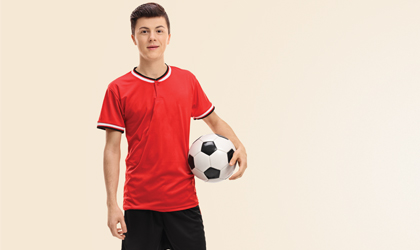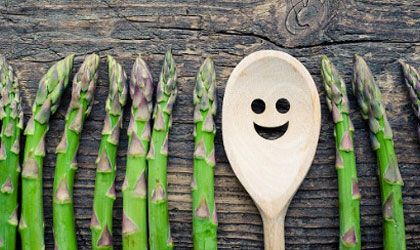
It’s possible that coughs, colds, and scraped knees will dominate the conversations you have about your child’s health – not bones. But, in truth, there’s no better time to start thinking about bone health than childhood. This stage of life will lay the foundation for your child’s skeletal system in the coming years. You see, the lifestyle habits developed in youth can make, and literally break, bones as they age. Here’s everything you need to know about nourishing your child’s bones.
Why is bone health so important in childhood?
Bones are the scaffolding that supports your child’s developing body. Far from being inert and idol, bones are living tissues that are constantly adapting to the demands of modern life, with old bone being removed and replaced in a process called ‘resorption’. It can be helpful to think of the skeletal system as a bank account. With your help and guidance, your child can make ‘deposits’ and ‘withdrawals’ of bone tissue. Nurturing your child’s ‘bone bank’ is similar to saving for their university education: the more they put away when they’re younger, the longer the nest egg will last as they get older.
Throughout childhood and adolescence, significantly more bone is deposited than withdrawn as the skeleton develops in both density and size. Generally speaking, bone mass (the amount of bone tissue in the skeleton) peaks by late twenties. At this age, bones have reached their optimal density and strength. Approximately 90 per cent of peak bone mass is attained by the age of 18 in girls and 20 in boys, meaning childhood really is the best time to invest in bone health.
Factors that affect peak bone mass
Myriad factors will affect your child’s bone health as they grow – some you can influence, like nutrition and exercise, and others you can’t, like gender and hormones.
Gender
Typically, bone mass density is much greater in men than women. Prior to puberty, boys and girls are on an equal playing field when it comes to bone mass. After puberty, however, boys will usually attain higher bone mass than their female counterparts.
Hormones
The sex hormones – oestrogen and testosterone – are vitally important in the development of bone mass. If a girl frequently misses her period, it may signal that she has lower bone density. On the other hand, those who start menstruating at an earlier age usually have higher bone density.
Nutritional intake
Adequate intake of calcium and vitamin D is a building block of happy, healthy bones. A well-balanced diet delivering optimal levels of magnesium, zinc, vitamin C, and omega-3 is essential, too.
Physical activity
Exercise is another powerful weapon to cultivate strong bones, providing the greatest benefits in the areas of the body that bear the most weight, such as hips during running and arms during weight lifting.
Best ways to keep your child’s bones healthy
You may not think it, but one of the best ways for your children to develop healthy bones is by being a role model yourself. Children are like sponges; the way you live your life will, of course, influence them. Two of the most important habits to encourage from the get-go are proper nutrition and plenty of exercise. If you make these two goals a priority, you’ll give your children and their skeletal system the best start in life.
Nutrition
Cram in calcium
Yes, the well-worn cliché rings true: calcium is delicious bone food. Alongside being a building block of your child’s skeleton, this mineral is needed for nearly every biological function. Problem is, if calcium stores run dry, the body will leach it hungrily from bones, making them brittle, porous, and prone to breakages. As the TV ads will tell you, the numero uno calcium source is dairy: milk, yoghurt, and cheese (side note: ripe cheese is a rich source of the bone-bolstering nutrient vitamin K, too). But if your child isn’t mad on the white stuff, fear not. Dark leafy green veggies (kale, broccoli, and spinach), canned fish (salmon, sardines, and tuna), almonds, seeds, beans, and lentils also deliver a tasty amount of calcium. To ensure your child is getting enough of this bone-bolstering mineral, try serving a portion of calcium-rich food at every mealtime. Oh, and don’t forget to stock up on calcium-dense snacks, either. Cheese cubes, frozen yoghurt, fortified cereal with milk, almonds, and raw broccoli will keep both hungry children and bones happy.
Vital vitamin D
However, you can’t have calcium without adequate levels of vitamin D. These bone-building nutrients work in tandem to keep bones strong and healthy: calcium bolsters bone, and vitamin D supports the proper absorption and utilisation of calcium. Ultimately, intake of calcium and vitamin D must be optimal to fully realise the impact of each nutrient on your bones. That’s why you need to encourage your child to get as much vitamin D as possible. From late April to September, it’s possible for your little one to get enough vitamin D from 15-minutes of direct sunlight each day (if they’re spending any more time in the sun, be sure to whip out the sun cream!). When natural sunlight isn’t so readily available in winter, encourage them to eat more vitamin-D rich foods, such as oily fish (salmon, trout, mackerel, and herring), some pork products, eggs, mushrooms, and fortified foods like orange juice, breads, and milk. Alternatively, you could add a vitamin D supplement that packs 10mcg to your child’s diet, which comes highly recommended by the NHS and Public Health Englandi.
Go green
Your children may turn their noses up at veggies, but there’s good reason why they are so darn nourishing. Amongst a raft of impressive health credentials, greens are brimming with bone-building nutrients, like vitamin C and magnesium. Vitamin C supports the production of collagen, which is an important component of your bone structure. Magnesium, on the other hand, aids with the proper absorption and utilisation of calcium. Where possible, encourage your kids to chow down on five portions of veggies every day. Dark leafy greens, like kale, spinach, and Swiss chard, serve up some of the tastiest bone-building vitamin C and magnesium. If your child can’t stomach the greenery, try blending a handful of spinach along with a banana, avocado, and almond milk in a smoothie. Trust us, they won’t even taste the spinach – promise!
Promote exercise
Just like muscles, bones get stronger the more work they do. And that’s why exercise needs to be a mainstay of your child’s lifestyle. While any form of physical activity is great, weight-bearing exercise – dancing, tennis, running, walking, football, basketball, and hiking – reigns supreme for bone health. Strength training, such as weight lifting, can bolster bones, too. Ultimately, you want to encourage your child to move more and sit less. Whether it’s working out with friends, alone, or in a team, we wholeheartedly believe that equipping your kids with a lifelong love of exercise is one of the best gifts you can give them. The NHS suggests children and young people (aged 5 to 18) should be active for at least 60 minutes every dayii. Added bonus: exercise doesn’t just build healthy bones; it also builds confidence!
Ensure your child is eating enough
Eating too little can deprive the body of vitally important nutrients, wreak havoc with metabolism, and skew hormone production. And dropping into a calorie deficit can severely compromise bone health in childhood and adolescence. If your child is endlessly dieting, it’s very possible he or she won’t be getting enough calcium and vitamin D to support growing bones. For girls, eating disorders, like anorexia nervosa, can throw hormones out of whack, triggering irregular periods or amenorrhea – the absence of periods altogether. A missed period often signals low levels of the hormone, oestrogen, which is essential for developing bone density and achieving peak bone mass. And reduced levels of oestrogen in adolescence may increase the risk of fracture and low bone density in later life. If your child has rapidly lost weight, eats very little, focuses on low-calorie foods, or over exercises, it may be time address this issue.
Warn against smoking
Surprised to see this mentioned here? Don’t be. This fiercely addictive habit often starts in adolescence. Beyond affecting heart and lung health, cigarette smoke threatens bone health, too. Data consistently references links between smoking and an increased risk of fracturesiii. With this in mind, one of the best things you can do as a parent is warn your child against smoking. Don’t forget your lifestyle will also rub off on your children. Try to be expert role models and avoid smoking yourself – and certainly not in front of your kids.
References:
-
GOV.UK. (2019). PHE publishes new advice on vitamin D. Available online: https://www.gov.uk/government/news/phe-publishes-new-advice-on-vitamin-d [Accessed 29 Apr. 2019].
-
NHS.UK. (2019). Physical activity guidelines for children and young people. Available online: https://www.nhs.uk/live-well/exercise/physical-activity-guidelines-children-and-young-people [Accessed 29 Apr. 2019].
-
Law. M.R., Hackshaw. A.K. (1997). A meta-analysis of cigarette smoking, bone mineral density and risk of hip fracture: recognition of a major effect. BMJ. ;315:841-6.
Cooper. C., Atkinson. E.J., Jacobsen. S.J., O'Fallon. W.M., Melton. L.J. (1993). Population-based study of survival after osteoporotic fractures. Am J Epidemiol. ;137(9): 1001-5.
You Might Also Like

Olivia
Olivia Salter has always been an avid health nut. After graduating from the University of Bristol, she began working for a nutritional consultancy where she discovered her passion for all things wellness-related. There, she executed much of the company’s content marketing strategy and found her niche in health writing, publishing articles in Women’s Health, Mind Body Green, Thrive and Psychologies.
View More



